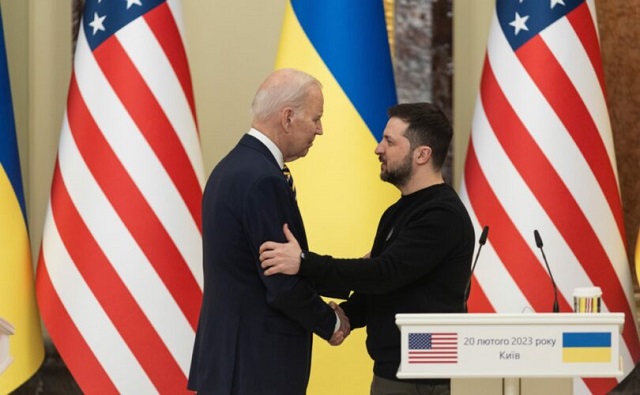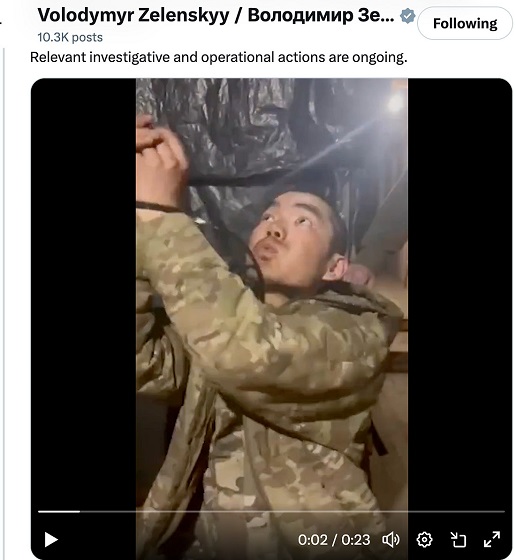conflict
Biden gives green light for Ukraine to shoot US-provided missiles into Russian territory

From LifeSiteNews
This is a major escalation of NATO engagement, likely intended to provoke Russia to strike alternate targets.
According to Politico and the New York Times the Biden administration has given Ukraine approval to launch U.S.-provided missiles into Russia. This is a major escalation of NATO engagement, likely intended to provoke Russia to strike alternate targets. The people inside Ukraine responsible for using these U.S. provided weapons are likely not Ukrainian.
CTH is in an unusually serendipitous position to analyze how Russia is responding to this shift in U.S. position. The morale inside Russia is very high amid the military-age population. The recruitment efforts of the Russian government appear to be numerous and very effective.
There are thousands of newly enlisted military personnel very visible in/around training facilities. There is no apparent tension discernable. Overall Russia appears to take great pride in their military, and it is considered a matter of honor and pride to support them.
From Politico:
The Biden administration has quietly given Ukraine permission to strike inside Russia – solely near the area of Kharkiv – using U.S.-provided weapons, two U.S. officials and two other people familiar with the move said Thursday, a major reversal that will help Ukraine to better defend its second-largest city.
‘The president recently directed his team to ensure that Ukraine is able to use U.S. weapons for counter-fire purposes in Kharkiv so Ukraine can hit back at Russian forces hitting them or preparing to hit them,’ a U.S. official said, adding that the policy of not allowing long-range strikes inside Russia ‘has not changed.’
… In effect, Ukraine can now use American-provided weapons, such as rockets and rocket launchers, to shoot down launched Russian missiles heading toward Kharkiv, at troops massing just over the Russian border near the city, or Russian bombers launching bombs toward Ukrainian territory. But the official said Ukraine cannot use those weapons to hit civilian infrastructure or launch long-range missiles, such as the Army Tactical Missile System, to hit military targets deep inside Russia.
It’s a stunning shift the administration initially said would escalate the war by more directly involving the U.S. in the fight. But worsening conditions for Ukraine on the battlefield – namely Russia’s advances and improved position in Kharkiv – led the president to change his mind.
You can tell from the general vibe amid the officials of government, Russia is not playing around with their military approach toward previous NATO encroachment or the provocations by the U.S. The sense is that Russia is in this for the long haul and their structural changes in the aftermath of the sanction regime are not temporary. Russians overall are hard and resilient to the reality of things as they are, not as they would wish them to be.
Russia appears to be entirely prepared financially, sociologically, and economically to remain disconnected from the “West.” Asia and India are filling the economic void created by Western sanctions. Amid ordinary life, the general Russian sentiment seems to be one of acceptance to the geopolitical isolation.
In recent weeks, the push toward further conflict with Russia seemed to be diminishing; however, this direct action by Biden and the State Dept. puts the U.S. (NATO) in a more aggressive posture.
Hungarian Prime Minister Viktor Orbán opposes the escalation by NATO:
During a Friday interview on state radio, Orbán said that French President Emmanuel Macron’s stance that he wouldn’t rule out sending troops to Ukraine, as well as a NATO proposal that would allow Kyiv to strike military bases inside Russia with sophisticated long-range weapons provided by Western partners, risked escalating the war in Ukraine into a global conflict.
‘War is a monster that is constantly hungry, it must be fed, and it must be fed with money. And I see that the Americans and the Democratic government of the United States, and the leaders of the European Union, are ready to feed it,’ he said.
Reprinted with permission from the Conservative Treehouse.
conflict
Zelensky Alleges Chinese Nationals Fighting for Russia, Calls for Global Response

 Sam Cooper
Sam Cooper
Ukrainian President Volodymyr Zelensky announced Tuesday that his forces have captured two Chinese citizens fighting as part of the Russian army in eastern Ukraine, alleging “there are many more Chinese citizens in the occupier’s units.” The stunning revelation could inject a volatile new dimension into ceasefire negotiations between the United States and Russia—and intensify already fraught tensions over Taiwan.
Zelensky shared the news in an X post, accompanied by video of one of the captured men—an Asian male in beige fatigues, hands bound with zip ties, visibly distressed as he gestures to a Ukrainian camera operator. The video shows the man making whirring sounds, crouching instinctively as if a drone is circling above and opening fire—then glancing up and uttering the English word, “commander.”
“We have information suggesting that there are many more Chinese citizens in the occupier’s units than just these two,” Zelensky wrote on X. “We are currently verifying all the facts—intelligence, the Security Service of Ukraine, and the relevant units of the Armed Forces are working on it.”
The president said he has instructed Ukraine’s foreign minister to urgently contact Beijing to clarify how China intends to respond.
“Russia’s involvement of China, along with other countries, whether directly or indirectly, in this war in Europe is a clear signal that Putin intends to do anything but end the war,” Zelensky wrote. “He is looking for ways to continue fighting. This definitely requires a response. A response from the United States, Europe, and all those around the world who want peace.”
Zelensky added that Ukrainian authorities had recovered documents, bank cards, and personal data from the two prisoners—material that could be pivotal in discovering the nature of China’s involvement.
If verified, the presence of Chinese nationals fighting for Russia could carry sweeping geopolitical implications. It would complicate delicate U.S.-Russia negotiations aimed at exploring a conditional ceasefire, and could have indirect ramifications on the plans of Washington, Tokyo, and Taipei in their growing confrontation with Beijing.
China has repeatedly denied providing direct military support to Russia. Zelensky’s statement marks the first time Ukraine has publicly alleged that Chinese nationals are embedded in Russian combat units—an allegation that, if substantiated, could alter the strategic calculus in both Eastern Europe and the Indo-Pacific.
Responding to Zelensky’s claims, Tom Shugart, a senior defense analyst at the Center for a New American Security and a former U.S. Navy officer, emphasized that the strategic implications hinge on whether the Chinese nationals were acting as mercenaries or state-directed personnel. “If the PRC is actively providing soldiers to fight in Ukraine, that would be altogether different—a possible sign of a real Axis that may best be resisted wherever it is fighting,” he wrote on X.
This is a developing story. The Bureau will continue to report as further details emerge.

Recommend The Bureau to your readers
conflict
“HELL WILL RAIN DOWN”: Trump unleashes U.S. military on Yemeni Houthis

 MxM News
MxM News
Quick Hit:
President Trump ordered a massive military assault on Iranian-backed Houthi forces in Yemen on Saturday, vowing to unleash “overwhelming lethal force” after months of attacks on American and allied vessels in the Red Sea.
Key Details:
-
Trump announced the strikes in a Truth Social post, stating, “Today, I have ordered the United States Military to launch decisive and powerful Military action against the Houthi terrorists in Yemen.”
-
He criticized former President Joe Biden for failing to contain the Houthis, saying his response was “pathetically weak” and emboldened the group’s ongoing attacks on commercial and military vessels.
-
The U.S. Navy’s USS Harry S. Truman carrier strike group, along with three destroyers and a cruiser, launched the assault, targeting radars, air defenses, and missile systems used to disrupt shipping lanes.
CENTCOM Forces Launch Large Scale Operation Against Iran-Backed Houthis in Yemen
On March 15, U.S. Central Command initiated a series of operations consisting of precision strikes against Iran-backed Houthi targets across Yemen to defend American interests, deter enemies, and… pic.twitter.com/u5yx8WneoG
— U.S. Central Command (@CENTCOM) March 15, 2025
Diving Deeper:
President Trump escalated U.S. military action against Iran-backed Houthi rebels on Saturday, ordering airstrikes on targets in Yemen in response to the group’s repeated attacks on Red Sea shipping. Trump, in a Truth Social post, declared that the U.S. military would not tolerate continued aggression and vowed an overwhelming response.
“The Houthi attack on American vessels will not be tolerated,” Trump wrote. “We will use overwhelming lethal force until we have achieved our objective.” He directly warned the Houthis, stating, “YOUR TIME IS UP, AND YOUR ATTACKS MUST STOP, STARTING TODAY. IF THEY DON’T, HELL WILL RAIN DOWN UPON YOU LIKE NOTHING YOU HAVE EVER SEEN BEFORE!”
The strikes, carried out by U.S. Central Command, targeted missile sites, drone launch facilities, and command centers used by the Houthis to strike commercial and military vessels in the Red Sea. U.S. warships and carrier-based fighter jets participated in the mission, marking a significant escalation in efforts to protect international shipping routes.
Trump also issued a direct warning to Iran, demanding that its support for the Houthis “must end immediately.” Addressing Tehran, Trump wrote, “Do NOT threaten the American People, their President…or Worldwide shipping lanes. If you do, BEWARE, because America will hold you fully accountable and we won’t be nice about it!”
The strikes come after more than a year of escalating attacks by the Houthis, who have targeted over 100 merchant vessels, sunk at least two, and killed multiple sailors since the Israel-Hamas war began. Trump pointed to Biden’s failures in handling the crisis, noting that “it has been over a year since a U.S.-flagged commercial ship safely sailed through the Suez Canal, the Red Sea, or the Gulf of Aden.”
With Trump’s order, the U.S. is making clear that hostile actions in the Red Sea will not go unanswered. As military operations continue, all eyes will be on whether the Houthis and their Iranian backers heed the warning—or face even greater firepower from the U.S. military.
-

 Alberta15 hours ago
Alberta15 hours agoProvince to expand services provided by Alberta Sheriffs: New policing option for municipalities
-

 Bruce Dowbiggin10 hours ago
Bruce Dowbiggin10 hours agoIs HNIC Ready For The Winnipeg Jets To Be Canada’s Heroes?
-

 2025 Federal Election12 hours ago
2025 Federal Election12 hours agoCSIS Warned Beijing Would Brand Conservatives as Trumpian. Now Carney’s Campaign Is Doing It.
-

 2025 Federal Election14 hours ago
2025 Federal Election14 hours agoNo Matter The Winner – My Canada Is Gone
-

 Alberta13 hours ago
Alberta13 hours agoMade in Alberta! Province makes it easier to support local products with Buy Local program
-

 Health11 hours ago
Health11 hours agoHorrific and Deadly Effects of Antidepressants
-

 2025 Federal Election2 days ago
2025 Federal Election2 days agoThe “Hardhat Vote” Has Embraced Pierre Poilievre
-

 COVID-192 days ago
COVID-192 days agoThe Pandemic Justice Phase Begins as Criminal Investigations Commence





